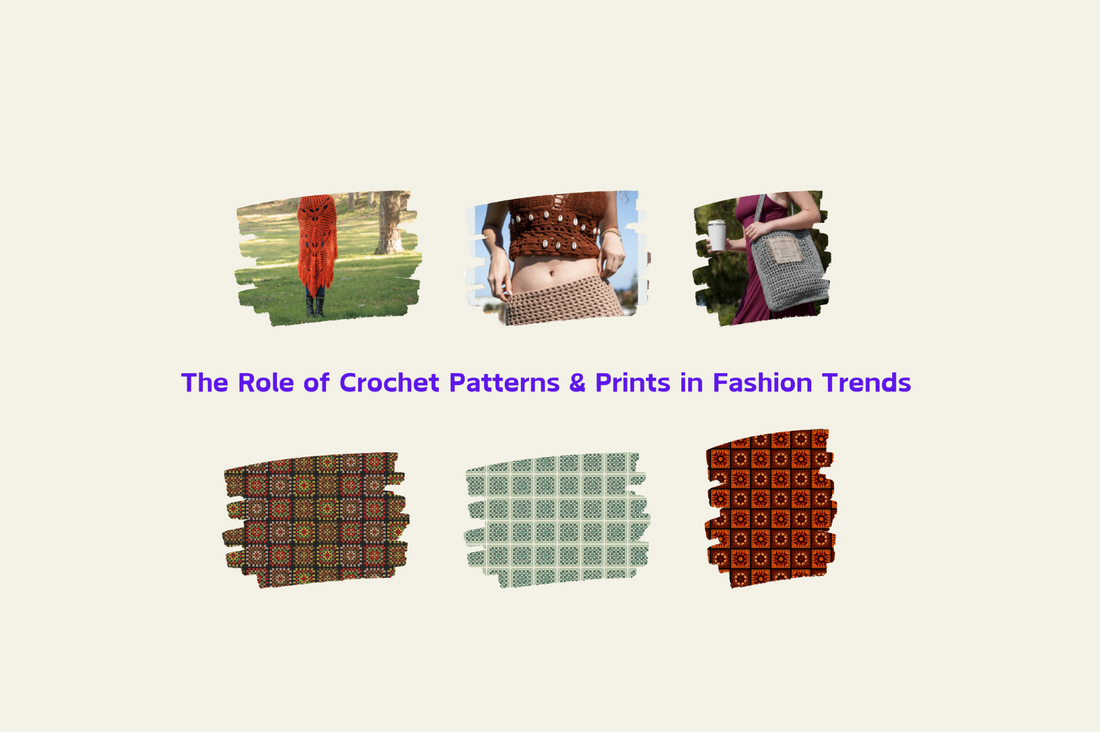
The Role of Crochet Patterns in Fashion Trends
Share
Crochet has long been associated with craftsmanship, handmade artistry, and vintage aesthetics. However, in recent years, it has evolved beyond its traditional roots, influencing contemporary fashion in fresh and exciting ways. From high-fashion runways to high-street collections, crochet-inspired designs have become a key trend, blending nostalgia with modernity.
In this post, we’ll explore crochet’s journey through fashion history, its modern resurgence, and how digital crochet patterns are shaping the industry’s future.
A Brief History of Crochet in Fashion
While the exact origins of crochet remain debated, it gained widespread popularity in Europe during the 19th century. Initially, crochet was an affordable alternative to lace, allowing intricate designs to be created without expensive materials. By the 1920s, crochet had made its way into fashion, appearing in evening wear, accessories, and delicate embellishments.
The 1960s and 1970s saw crochet reach peak popularity, particularly within the bohemian and hippie movements. Bold, colourful crochet garments—such as maxi dresses, ponchos, and halter tops—dominated the era, representing a rejection of mass-produced clothing in favour of handmade artistry.
By the 1990s and early 2000s, crochet had faded slightly from mainstream fashion, appearing primarily in beachwear and festival styles. However, the 2020s have marked a full-fledged revival, with designers and consumers embracing crochet in new and unexpected ways.
Crochet’s Modern Revival in Fashion
Over the past decade, crochet has transitioned from a nostalgic craft to a staple in contemporary fashion. Unlike the homespun aesthetics of the past, today’s crochet styles are refined, versatile, and fashion-forward.
Luxury Fashion and Crochet
High-fashion brands have played a significant role in crochet’s resurgence, integrating it into their collections with a modern twist. Luxury interpretations showcase how crochet has moved beyond DIY aesthetics, becoming a statement of high-end fashion.
Crochet on the High Street
As crochet gains traction in luxury fashion, high-street retailers have followed suit, incorporating crochet-inspired tops, skirts, and dresses into their seasonal collections.
However, the rise of machine-made crochet-look garments raises concerns about authenticity and sustainability. True crochet is a time-consuming craft, often handmade by artisans, while mass-produced alternatives may lack the same ethical and artistic value.
Digital Crochet Patterns and the Future of Design
The fusion of traditional crochet with modern technology has opened new possibilities for designers. Digital crochet patterns allow for greater precision, efficiency, and creativity, bridging the gap between craftsmanship and scalability.
How Technology is Shaping Crochet Fashion
- CAD (Computer-Aided Design) Tools: Designers can create intricate crochet patterns digitally, reducing human error and ensuring consistency.
- 3D Printing: Some designers are experimenting with 3D-printed crochet textures, mimicking handwoven patterns with innovative materials.
- Sustainability: Digital crochet designs allow brands to optimise textile use, minimising waste and supporting ethical production.
These advancements mean that crochet’s influence in fashion will continue evolving, moving beyond traditional handcrafting into innovative and sustainable design methods.
Sustainability and Slow Fashion: Why Crochet is the Perfect Fit
As consumers become more eco-conscious, crochet aligns perfectly with the values of slow fashion. Unlike fast fashion’s disposable trends, crochet pieces are typically handmade, designed to last, and often crafted with sustainable materials.
The Handmade Revolution
The appeal of handmade crochet garments is growing, with independent designers selling custom pieces on platforms like Etsy and Depop. Consumers are increasingly drawn to unique, one-of-a-kind items, valuing the time and skill involved in their creation.
Upcycling with Crochet
Many sustainable brands use crochet techniques to repurpose old fabrics and yarns, reducing textile waste. This approach not only supports ethical fashion but also showcases crochet’s versatility in transforming discarded materials into stylish, wearable art.
How to Style Crochet in 2025 and Beyond
With crochet’s increasing popularity, styling it in a fresh, modern way is essential. Here are some contemporary approaches to incorporating crochet into everyday fashion:
Minimalist Crochet
For a sleek, refined look, choose crochet pieces in neutral tones like white, beige, or soft pastels. A crochet midi dress paired with minimalist accessories creates an effortlessly chic outfit.
Layering with Crochet
Layering crochet over structured garments adds texture without overwhelming an outfit. A crochet vest over a crisp shirt or a crochet cardigan over a slip dress offers a balanced, stylish contrast.
Bohemian and Festival Styles
Crochet remains a festival staple, with crochet crop tops, maxi skirts, and fringe accessories embodying the boho-chic aesthetic. Pairing crochet with denim or leather creates a modern, edgy twist.
High-Fashion Crochet
For a sophisticated look, structured crochet pieces—such as blazers, fitted dresses, or statement handbags—can elevate an outfit from casual to couture. Mixing crochet with unexpected materials, like silk or metallics, adds a contemporary edge.
Conclusion
Crochet has transcended its vintage roots to become a significant force in modern fashion. With its blend of craftsmanship, digital innovation, and sustainability, it continues to evolve, shaping the industry in exciting ways.
Whether through hand-crafted artistry or technology-driven designs, crochet remains a timeless fashion statement—one that is set to inspire future generations of designers and consumers alike.
